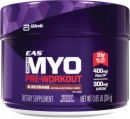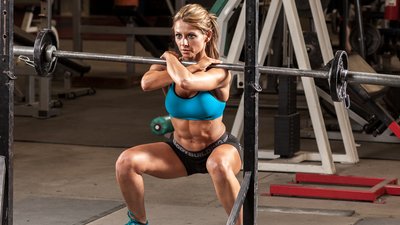itness has its own share of tall tales. You've heard the ones about sculpting your six-pack with daily high-rep crunches, right? How about the little boy whose knees fell off after a single squat? Far too many of us have let our lives be steered by these yarns over the years, with nothing to show for it in the end. You deserve better!
To help separate myth from reality, we turned to two EAS athletes who have seen and heard all sorts of pumped-up fitness parables over the course of their careers: active duty Coast Guard member Steven Lopez and NPC bikini competitor Nikki Walter.
Here's what they had to say about six of the most persistent legends passed down through generations of iron enthusiasts.
Myth 1: Crunches Are Necessary For A Six-Pack
We get it: crunches burn so much when you do them they simply must be building something, right? Alas, wrong. Even the best direct ab exercises only strengthen the muscles underneath the flab. That doesn't mean they're not useful, but rather that they're only useful at certain times for certain goals.
"Listen, we all have 'abs,' regardless of how high our body-fat percentage is," Lopez explains. "It's when you diet and exercise the whole body that those muscles become more visible. The key to a chiseled six-pack is sticking to a good overall workout routine and clean diet."

Front squats torch your six-pack muscles and plenty more. Are you doing them?
Got that? The overall quality of your approach is far more important than any small part. This is what Bill Geiger was writing about when he described the EAS Muscle-Building Pyramid: Start with the big, and then work your way to the small.
"Yes, exercises that directly work the abdominals can make the muscles more detailed and defined," Lopez points out. "But that effort will only pay off when you peel away the layer of body fat over them. So start there."
Just to be clear, a crunch is also not unique in its ability to work the "six-pack muscles" of the rectus abdominus. All of the following absolutely scorch the rectus and every other ab muscle, creating core strength that can carry over to everything else you do in the gym!
Exercises that work the six pack muscles and then some:
- Strict hanging leg raise
- Front squat (all implements)
- TRX fall-out
- Mountain climber
- Plank with reach
- L-sit
- Stability-ball roll-out
- Stability-ball pike
- Ab roll-out
- Hollow-body hold
Myth 2: Tons Of Cardio Is Necessary To Get Even A Little Lean
Slow-and-low cardiovascular training is a great tool—in the right time, amount, and place. But if you want to lose fat, you probably need less of it than you think, unless you're already lean and looking to get leaner.
"I've found that the average person trying to get lean can accomplish that with just a good weight workout routine and diet," explains Lopez. "However, if you compete or are prepping for a shoot, cardio is necessary to get rid of those last few pounds of stubborn fat in the final weeks of prep."

Yes, you can enjoy your life while you're transforming it. Don't let anyone convince you otherwise!
Until then, you might get better results from blended cardio and bodyweight training—the type that EAS's four "Transformed in 20" workouts contain in spades.
For guys, the most stubborn fatty areas are usually the love handles, lower abs, and lower back; for women, it's usually the hips, butt, and thighs. "These areas have a high amount of alpha-receptors, which are more insulin sensitive and receive less blood flow," Lopez says. "After being on prep for, say, 13-15 weeks, you might hit a fat-burning plateau and notice those areas are the last to get really lean. When that time comes, consider getting on the treadmill to help dial it in."

Myth 3: You Must Disappear From Life If You Want To Lose Fat
There's nothing like trying to transform your physique to make you start viewing the world starkly in terms of do's and don'ts. Just watch the next time someone brings a cake into the office, and you'll quickly notice two "teams" develop: those who partake, and those who don't.

You might get better results from blended cardio and bodyweight training—the type that EAS's four "Transformed in 20" workouts contain in spades.
"Until I started competing and committed myself to a strict diet, I just wasn't aware of how much of our social lives revolved around food and drinks," Walter says. "I used to experience this working in an office, when others would bring in food to celebrate. Office settings are hard when co-workers want to bring treats in or go out to happy hour after work. No one wants to be the antisocial one."
You want cake—but you want results, too. So what's an aspiring athlete to do? As with training abs, you have to trust the overall approach to handle the big part of the results. If you're confident in 90 percent of your nutritional approach—both the what and the why—it's easier to say either "no thanks" or "just a bit" and really mean it.
"Go out and be social, but be prepared at work with your own snacks, or limit yourself to one treat a week—whatever will help you focus on the lifestyle change you're aiming for," Walter says.
Myth 4: Squats Are Bad For Your Knees
This idea has many people scared squatless, as those fearful of injury have steered clear of what arguably is the most productive weight-training exercise ever devised. The squat, after all, works a multitude of muscles synergistically, including the quadriceps, hamstrings, and glutes, as well as the core and upper body.
It's entirely possible that a lifetime of sitting (among many other factors) may have gotten in the way of your ability to squat deeply with good form. Squatting heavy before you can squat well is also a major culprit. But with patience and a focus on mobility, you can absolutely regain your squat!
And what's more, you should. The lower reaches of the range of motion, as they stop short of going all the way down to where the thighs are parallel to the floor or below, are where some of the squat's biggest benefits are to be found.
"If your knees are tracking out past your toes, start by widening up your stance a bit to allow you to at least go to parallel. Over time, work on getting better at full-ROM squats, and they'll more than earn their place in your leg-day routine," Lopez says.
In other words, don't leap to a heavy quarter-squat at the expense of learning how to do a light full squat. Start practicing light (or bodyweight) full squats, and then slowly add weight. Exercises like the goblet squat can certainly help you get there. They teach great squat form without requiring you to get under a heavy load.
Myth 5: Machines Are Safer Than Free Weights
Because you're locked into a specific range of motion with the resistance tucked away on a weight stack versus being in hand via a dumbbell or barbell, many assume machines are naturally safer than free weights. But is this true?
The answer is a huge "it depends." Yes, you may be less at risk of hurting your knee today doing some leg extensions than doing a poor-quality, overly heavy squat. But you're also doing a lot less to strengthen your body as a whole, including all those tiny stabilizer muscles that make you feel as strong as you look.

Machines work best as the dessert after the main course of big lifts. But if your goal is bigger quads, they definitely have their place!
The precise thing that makes a squat so difficult—namely, your body being forced to stabilize during a difficult movement—is what makes it valuable. A well-performed squat, even just with body weight, teaches your muscles to fire and work together. A machine just hammers a muscle or two. One is a symphony; the other is a solo.
"Of course, machines have their place in a workout routine," Lopez says. "But they're just one ingredient. As long as you check your ego at the door when it comes to weight selection and use proper form, machines, cables, free weights, and bodyweight exercises are all the same as far as safety goes. Each provide their own unique way of targeting a muscle group. Use them all for what they're best at."
Myth 6: Supplements Are Only Useful For Muscle Building
There are two things that are about as timeless in the fitness industry as the dumbbell itself: the sound of a big guy in the weight room rattling a shaker cup, and the magazine ad of a ripped bodybuilder roaring into the camera.

We've all seen them both a million times by now. But their popularity comes with a downside: A generation of people have seemingly become convinced that supplements are only for people who either already have tons of muscle or who are desperately in pursuit of it.
As Nikki Walter found out when she wanted to transform her life, this just isn't the case. "Supplements can be scary for someone who has never used them," she says. "Had I known several years ago, back when I was a marathon runner, how much supplementation can assist with recovery and performance, I would have saved myself a lot of hassle."
Ask any of the millions who have successfully completed the EAS Body for Life challenge over the last 20 years, and they'll echo Walter's conclusion. Yes, a protein shake is helpful to meet your daily protein target, but it's more helpful in its ability to fuel your recovery between workouts. Sure, a pre-workout is helpful for giving you energy, but only if that energy equals another rep, set, or movement you wouldn't have done otherwise.
Think of it this way: Choosing to commit to a lifetime with such an intense, challenging hour in it every day isn't easy. It isn't normal—even though it should be—but it's necessary. If a supplement can help you turn that daily ritual into something to be relished rather than feared or dreaded, well, that's worth considering for any athlete.
"It's worth your time to read reviews and embrace supplementation as an intellectual challenge," Walter says. "Knowing not only what to take, but also when to take supplements and how they support your goals are all key to success." Look for supplements that use transparent labeling, meaning you can see each ingredient and the exact dose used in the product, and carry third party certifications like GMP and NSF so that you know the product has been tested for safety and for banned substances.

